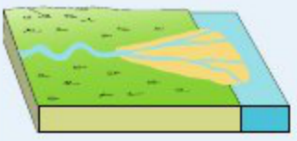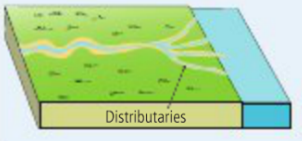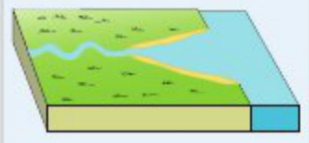Deltas - Feature of Deposition
Deltas are features of river deposition found in the old age stage (lower course of a river). They are deposits of alluvium found at the mouth of the river where it enters the sea/lake or another river. As a river flows into the sea it deposits the rest of its load according to size. This means that it deposits the heaviest material first and the lightest material is carried further and deposited last. If the tides and currents are not strong enough to carry the load out to sea the deposits of alluvium build up to form new land at the river mouth. The channel becomes choked causing the river to break up into smaller courses called distributaries. Not all rivers form deltas. In many areas currents and tides are strong enough to move the material away.
Types of delta:
1)Arcuate Delta: Triangle-shaped deltas formed of sands and gravels
2)Estuarine Delta: Formed at the mouth of submerged rivers depositing down the sides of the estuary.
3) Birds foot Delta: Deposited material divides the river into smaller distributaries.
4) Lacustrine Delta: Formed when a river flows into a lake.
Examples of Deltas: The Mississippi Delta, Louisianna, The Nile, Egypt, Lough Leanne, Kerry.
Types of delta:
1)Arcuate Delta: Triangle-shaped deltas formed of sands and gravels
2)Estuarine Delta: Formed at the mouth of submerged rivers depositing down the sides of the estuary.
3) Birds foot Delta: Deposited material divides the river into smaller distributaries.
4) Lacustrine Delta: Formed when a river flows into a lake.
Examples of Deltas: The Mississippi Delta, Louisianna, The Nile, Egypt, Lough Leanne, Kerry.



